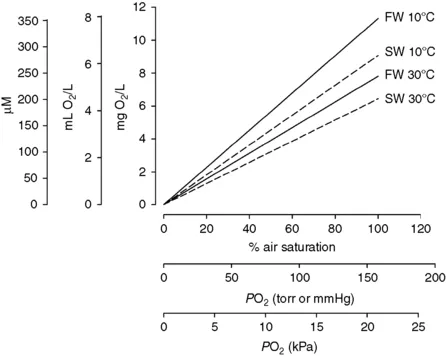Chapter 1 The Hypoxic Environment
Robert J. Diaz and Denise L. Breitburg
Low dissolved oxygen environments occur in a wide range of aquatic systems, and vary in temporal frequency, seasonality, and persistence. While there have always been naturally occurring low dissolved oxygen habitats, anthropogenic activities related primarily to organic and nutrient enrichment have led to increases in hypoxia and anoxia in both freshwater and marine systems. Lakes and coastal areas with seasonal stratification tend to be highly sensitive to the consequences of anthropogenic nutrient enrichment. Many systems that are currently hypoxic were not reported to have low dissolved oxygen concentrations when first studied. The rapid rise in the number of coastal hypoxic systems lagged about 20 years behind the increased use of industrial fertilizer. The future status of hypoxia and its consequences for fishes will depend on a combination of climate change (primarily from warming, and altered patterns for wind, currents, and precipitation) and land use change (primarily from expanded agriculture and nutrient loadings). If in the next 50 years humans continue to modify and degrade coastal systems as in previous years, human population pressure will likely be the main driving factor in spreading of coastal dead zones and climate change factors will be secondary. Climate forcing, however, will tend to make systems more susceptible to development of hypoxia through direct effects on stratification, solubility of oxygen, metabolism, and mineralization rates, particularly in lakes and semienclosed coastal areas.
1. Importance of Oxygen and Hypoxia
Oxygen is necessary to sustain the life of fishes and invertebrates dependent on aerobic respiration. When the supply of oxygen is cut off or consumption exceeds resupply, dissolved oxygen (DO) concentrations can decline below levels required by most animal life. This condition of low DO is known as hypoxia; water devoid of oxygen is referred to as anoxic and can contain lethal concentrations of metabolic products of microbial anaerobic respiration. Thus hypoxia and anoxia differ quantitatively in the availability of oxygen, as well as qualitatively in the presence of toxic compounds such as hydrogen sulfide. While many authors and water quality regulations focus on concentrations of DO below 2–3 mg O2/L as a threshold value for marine and estuarine environments, and 5–6 mg O2/L in some freshwater habitats, such arbitrary limits may be unsuitable when examining potential impacts of hypoxia on any one given species or on the way that oxygen concentrations affect interactions among species. Species and life stages differ in their basic oxygen requirements, and oxygen requirements increase as energy‐demanding metabolic processes are mobilized.
Depending on temperature and salinity, water contains 20–40 times less oxygen by volume and diffuses about ten thousand times more slowly through water than air (Graham, 1990). This relatively low solubility and diffusion of oxygen in water combined with two principal factors lead to the development of hypoxia and anoxia. These factors are density stratification of the water column that isolates the bottom water from exchange with oxygen‐rich surface water and the atmosphere, and decomposition of organic matter in the isolated bottom water that consumes dissolved oxygen. The combination of these factors can allow hypoxia to develop and persist in deeper waters by causing oxygen consumption to exceed resupply. For lakes, factors affecting vertical water mixing such as wind and temperature affect seasonal changes in the DO depth profile and can lower DO in bottom waters (Green et al., 1973). Ice and snow cover on lakes and streams can also block photosynthesis and reaeration, and may lead to hypoxia and “winterkills” (Greenbank, 1945, Magnuson et al., 1985 and Graham, 2006). In tropical freshwaters oxygenation is often greater in rainy seasons with more water flow than during dry stagnant water seasons (Val and Almeida‐Val, 1995; Graham, 2006).
Because of the low solubility of oxygen in water small changes in the absolute amount of oxygen dissolved in water (resulting from microbial or macrofaunal respiration) lead to large differences in per cent air saturation. Thus what appear to be small changes in DO can have major consequences to animals living in an oxygen‐limited milieu. For example, 9.1 mg O2 will dissolve in a liter of freshwater at 20°C; at this temperature a 1 mg O2/L drop in oxygen is equivalent to an 11% decline in air saturation (Figure 1.1). Going from freshwater to seawater (35 psu) at the same temperature reduces air saturation to 7.2 mg O2/L (Benson and Krause, 1984). Some species are particularly sensitive to even small changes in oxygen concentrations. For example, for some salmonids, the limiting factor of DO becomes operative at relatively high values and even air saturation can be limiting at higher temperatures (Fry, 1971).
Hypoxia has been a potent force in evolution. Air breathing and the ultimate evolution of terrestrial vertebrates is thought to have been an evolutionary response to low atmospheric and dissolved oxygen concentrations during the Devonian (Clack, 2007). Within aquatic environments, fishes have developed a wide range of mechanisms to secure more oxygen from their environment in situations where oxygen availability is critically low (Hoar and Randall, 1984, Brauner et al., 1995 and Gonzales et al., 2006). The large number of hypoxia‐tolerant aquatic species, and wide variety of anatomical, physiological, and behavioral adaptations to hypoxia, indicate that after the great atmospheric oxygenation event some 2.3 billion years ago (Catling et al., 2001), low DO environments have played an important role in the evolution of many adaptive strategies (Guppy and Withers, 1999, Val, 2000 and Bickler and Buck, 2007; see Chapters 2 to 9Chapter 2Chapter 3Chapter 4Chapter 5Chapter 6Chapter 7Chapter 8Chapter 9).
2. Hypoxia Distribution and Causes
2.1. Where Hypoxia Occurs
Oceanic oxygen minimum zones (OMZs) are the largest low DO areas on earth. OMZs form under areas of high surface productivity, which sinks and in the process of microbial metabolism oxygen is consumed (Figure 1.2). They are widespread and stable oceanic features occurring at intermediate depths (typically 400–1000 m), are particularly severe in regions of sluggish circulation, persist for long periods of time (at gre...

